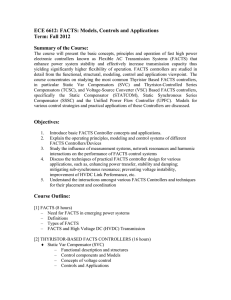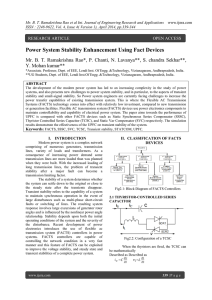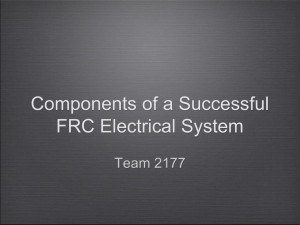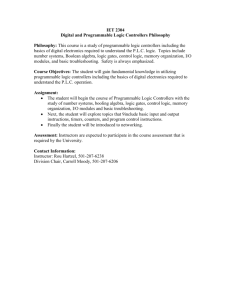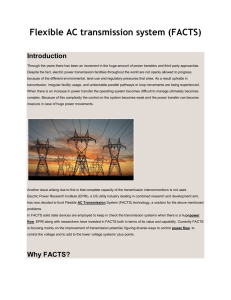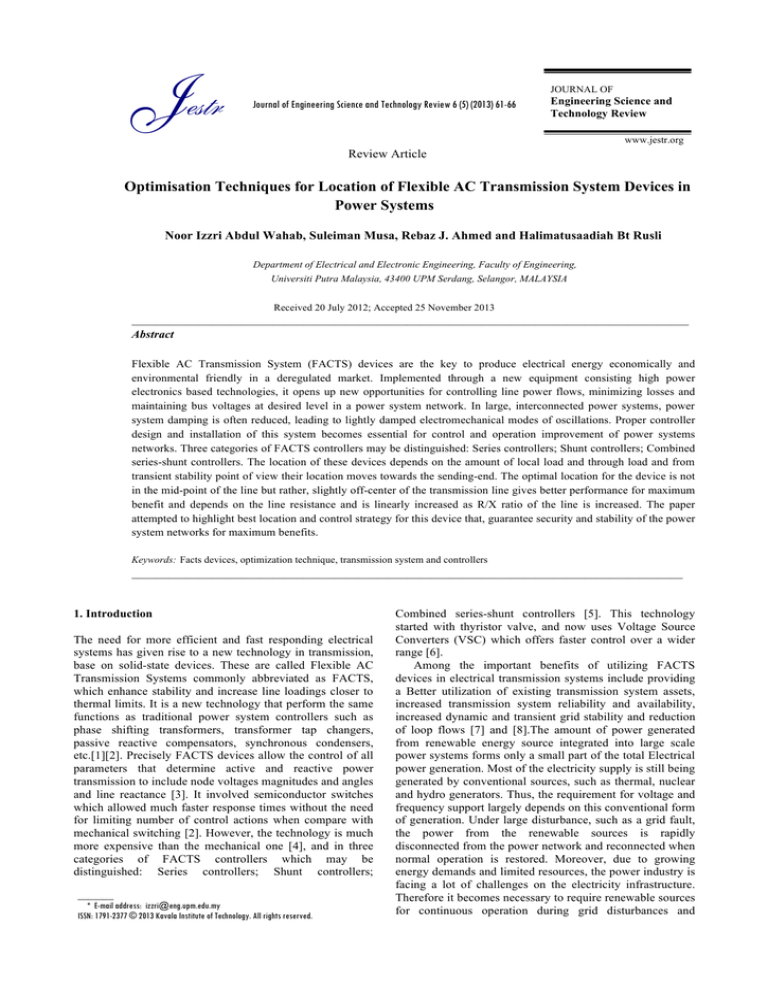
Jestr
Journal of Engineering Science and Technology Review 6 (5) (2013) 61-66 JOURNAL OF
Engineering Science and
Technology Review
www.jestr.org
Review Article
Optimisation Techniques for Location of Flexible AC Transmission System Devices in
Power Systems
Noor Izzri Abdul Wahab, Suleiman Musa, Rebaz J. Ahmed and Halimatusaadiah Bt Rusli
Department of Electrical and Electronic Engineering, Faculty of Engineering,
Universiti Putra Malaysia, 43400 UPM Serdang, Selangor, MALAYSIA
Received 20 July 2012; Accepted 25 November 2013
___________________________________________________________________________________________
Abstract
Flexible AC Transmission System (FACTS) devices are the key to produce electrical energy economically and
environmental friendly in a deregulated market. Implemented through a new equipment consisting high power
electronics based technologies, it opens up new opportunities for controlling line power flows, minimizing losses and
maintaining bus voltages at desired level in a power system network. In large, interconnected power systems, power
system damping is often reduced, leading to lightly damped electromechanical modes of oscillations. Proper controller
design and installation of this system becomes essential for control and operation improvement of power systems
networks. Three categories of FACTS controllers may be distinguished: Series controllers; Shunt controllers; Combined
series-shunt controllers. The location of these devices depends on the amount of local load and through load and from
transient stability point of view their location moves towards the sending-end. The optimal location for the device is not
in the mid-point of the line but rather, slightly off-center of the transmission line gives better performance for maximum
benefit and depends on the line resistance and is linearly increased as R/X ratio of the line is increased. The paper
attempted to highlight best location and control strategy for this device that, guarantee security and stability of the power
system networks for maximum benefits.
Keywords: Facts devices, optimization technique, transmission system and controllers
__________________________________________________________________________________________
1. Introduction
Combined series-shunt controllers [5]. This technology
started with thyristor valve, and now uses Voltage Source
Converters (VSC) which offers faster control over a wider
range [6].
Among the important benefits of utilizing FACTS
devices in electrical transmission systems include providing
a Better utilization of existing transmission system assets,
increased transmission system reliability and availability,
increased dynamic and transient grid stability and reduction
of loop flows [7] and [8].The amount of power generated
from renewable energy source integrated into large scale
power systems forms only a small part of the total Electrical
power generation. Most of the electricity supply is still being
generated by conventional sources, such as thermal, nuclear
and hydro generators. Thus, the requirement for voltage and
frequency support largely depends on this conventional form
of generation. Under large disturbance, such as a grid fault,
the power from the renewable sources is rapidly
disconnected from the power network and reconnected when
normal operation is restored. Moreover, due to growing
energy demands and limited resources, the power industry is
facing a lot of challenges on the electricity infrastructure.
Therefore it becomes necessary to require renewable sources
for continuous operation during grid disturbances and
The need for more efficient and fast responding electrical
systems has given rise to a new technology in transmission,
base on solid-state devices. These are called Flexible AC
Transmission Systems commonly abbreviated as FACTS,
which enhance stability and increase line loadings closer to
thermal limits. It is a new technology that perform the same
functions as traditional power system controllers such as
phase shifting transformers, transformer tap changers,
passive reactive compensators, synchronous condensers,
etc.[1][2]. Precisely FACTS devices allow the control of all
parameters that determine active and reactive power
transmission to include node voltages magnitudes and angles
and line reactance [3]. It involved semiconductor switches
which allowed much faster response times without the need
for limiting number of control actions when compare with
mechanical switching [2]. However, the technology is much
more expensive than the mechanical one [4], and in three
categories of FACTS controllers which may be
distinguished: Series controllers; Shunt controllers;
______________
* E-mail address: izzri@eng.upm.edu.my
ISSN: 1791-2377 © 2013 Kavala Institute of Technology. All rights reserved.
Noor Izzri Abdul Wahab, Suleiman Musa, Rebaz J. Ahmed and Halimatusaadiah Bt Rusli/
Journal of Engineering Science and Technology Review 6 (5) (2013) 61-66
thereby providing support for the network voltage and
frequency [9]. Some of the commonly used devices for this
support is the FACTS devices which include: Static
synchronous series compensator (SSSC), static synchronous
compensator (STATCOM), interline power flow controller
(IPFC), unified power flow controller (UPFC) and thyristor
controlled series compensator (TCSC) [10], [11] and [12].
Ideally these controllers should be connected to the power
system in a proper way because improperly placed
controllers fail to produce optimum performance and can
even be counterproductive, that’s why the placement of
these devices is of a great importance. Connecting shunt
FACTS device at the mid-point of a line, for example gives
the maximum benefit to the line. This was based on the
simplified model of the line neglecting the resistance and the
capacitance of the line. In this review, attempt is been made
to explore the best location of the FACTS on the
transmission line for optimum performance on the network.
transmitted power. The throughput active and reactive
powers can be control independently by the UPFC. The
versatility afforded by the UPFC makes it a prime contender
to provide many of the control functions needed in solving a
wider range of dynamic and steady-state problems
encountered in electrical power networks [14][15][16].
2. Facts Controllers
The FACTS controller provide a new platform in the control
of line power flows, minimizing losses and maintaining bus
voltages at desired level in a power system network. These
can be achieve by controlling one or more of the interrelated
system parameters including current, voltage, phase angle,
series impedance, shunt impedance, etc. with the insertion of
facts controllers in a power system network. Through these
devices the control of active and reactive power flow and the
bus voltages can be done easily. There are many types of
facts devices that have been invented and practically applied
to the power systems. The applications of each of these
controllers are different. They can be classified according to
the way they are being connected to the network. They can
be connected to the power system in series, shunt or a
combination of series and shunt as mention earlier in the
introduction. For series connected controllers there are:
Static Synchronous Series Compensator (SSSC), Thyristor
Controlled Series Capacitor (TCSC), Thyristor Controlled
Series Compensation (TCSC), Thyristor Controlled Series
Reactor (TCSR), Thyristor Switched Series Capacitor
(TSSC), Thyristor Switched Series Compensation (TSSC)
and Thyristor Switched Series Reactor (TSSR). For shunt
connected controllers: Battery Energy Storage System
(BESS), Static Synchronous Compensator (SSC Or
STATCOM),
Static
Condenser
(Statcon),
Static
Synchronous
Generator
(SSG),
Static
Var
Compensator(SVC), Static Var Generator Or Absorber
(SVG), Static Var System (SVS), Superconducting Magnetic
Energy Storage (SMES), Thyristor Controlled Braking
Resistor (TCBR), Thyristor Controlled Reactor (TCR),
Thyristor Switched Capacitor (TSC), Thyristor Switched
Reactor (TSR) And Var Compensating System (VCS). As
for combined shunt and series connected controllers:
Interphase Power Controller (IPC), Thyristor Controlled
Phase Shifting Transformer (TCPST) and Unified Power
Flow Controller (UPFC). The devices that are of a great deal
and widely available commercially, which are seen in many
literatures are: SVC, TCSC, UPFC, TCPST, and
STATCOM. [13]
Among the FACTS controllers, Unified Power Flow
Controller (UPFC), is the most complete. It is capable of
utilizing three basic electrical system variables [11] line
voltage, line impedance, and phase angle, that determine the
Fig. 1. UPFC Link in Transmission line
Two voltage source inverters (VSIs) form the basic
components of the UPFC. They are sharing a common dc
storage capacitor [17], and connected to the power system
via coupling transformers. One VSI is connected to in shunt
to the transmission system through a shunt transformer,
while the other one is connected in series via a series
transformer. A basic UPFC functional scheme is presented
in fig.1.
The series inverter is used to inject a symmetrical three
phase voltage system (Vc), of controllable magnitude and
phase angle in series with the line to control active and
reactive power flows on the transmission medium. The
reactive power is electronically produced by the series
inverter, and the active power is transmitted to the dc
terminals. The shunt inverter operates in such a way as to
demand this dc terminal power (positive or negative) from
the line keeping the voltage across the storage capacitor Vdc
constant. Therefore, the net real power absorbed from the
line by the UPFC is equal only to the losses of the inverters
and their transformers [18]. The remaining capacity of the
shunt inverter can be used to exchange reactive power with
the line so as to provide a voltage regulation at the
connection point. The two VSI’s can work independently of
each other by separating the dc side. Thus the shunt inverter
is operating as a STATCOM (Static Synchronous
Compensators) that produces or absorbs reactive power to
regulate the voltage magnitude at the point of connection.
“Instead, the series inverter is operating as SSSC (Static
Synchronous series compensators) that generates or absorbs
reactive power to regulate the current flow, and hence the
power flows on the transmission line.”[18]
Control strategy for FACTS controllers may be designed
by using intelligent, adaptive digital controllers based on
measured information obtained from wide-area networks. In
order to ensure the security of power-system operation by
coordination of multiple FACTS controllers in the same
62
Noor Izzri Abdul Wahab, Suleiman Musa, Rebaz J. Ahmed and Halimatusaadiah Bt Rusli/
Journal of Engineering Science and Technology Review 6 (5) (2013) 61-66
system as well as in the adjacent systems it is imperative that
the system be investigated extensively.
and observe that power transfer capacity can be increased or
decreased depending on the line selected for compensation.
3. Facts Controllers Locations
4. Location Criteria For The Device
Ideally FACTS devices should be connected to the power
system in a proper way because improperly placed FACTS
controllers fail to produce optimum performance and can
even be counterproductive, that’s why the placement of
these devices is of a great importance. [19] Certain
literatures reveal that connecting shunt FACTS device at the
mid-point of the line, gives the maximum benefit to the line.
This was based on the simplified model of the line
neglecting the resistance and the capacitance of the line.
However in recent works as in [20] at which practical cases
are considered and the exact model of the line is taken into
account, the results are much different from that calculated
for the simplified model. In this work it’s shown that the
optimal location for the device is not in the mid-point of the
line but rather slightly off-center of the transmission line
gives the maximum benefit. And it has been stated that the
best location from the center point depends on the line
resistance and is linearly increased as R/X ratio of the line is
increased. In [19] where two types of FACTS devices are
considered (SVC and STATCOM) which are both connected
to the line in shunt. It has been shown that the location of the
FACTS device is not fixed as stated by many researchers in
case of uncompensated lines but their location changes with
the change in the degree of series compensation. And it’s
almost linear with the degree of series compensation in
increment and its location moves towards the generator side
from the center point as the degree of series compensation is
increased. In [21] it’s stated that for an actual long
transmission line model with a predefined direction of real
power flow, shunt facts device needs to be allocated slightly
off-center. Further the location of these devices depends on
the amount of local load and through load and from transient
stability point of view their location moves towards the
sending-end, See figure 2.
The locations of these devises are based on several criteria’s
which include for example, Sensitivity-Based approach,
Artificial Intelligence methods, Point of Voltage Collapse
method, Nodal analysis, Frequency response, stability index
and Control theories. Generally, the location of FACTS
devices depends on the objective of the installation. The
optimal location can be guided by increasing system load
ability [23],[24],[25] and [26], thus minimizing the total
generation cost, and enhancing voltage stability [27].
FACTS devices can be placed in the power networks for
different reasons and their locations can be determined by
applying different techniques. For instance, FACTS devices
can be used for voltage stability and
reactive power
compensations, controlling the power flow and enhancing
the dynamic stability. There are several algorithms in use for
this work, such as genetic algorithm (GA), Bee’s algorithm
(BA), Evolutionary programming and particle swarm
optimization (PSO). It is much more complicated to place
several types of FACTS devices and the location of each one
in the system. One of the methods to find the best position
for the FACTS devices and the best number of FACTS
devices is the particle swarm optimization (PSO). In PSO
first the bus data, line data, and number of FACTS devices
are given as inputs, and then the initial population of
individuals is created in normalized form so as to satisfy the
FACTS device’s constraints. After that each individual in
the population, the fitness function is evaluated after
simulating all possible single and multiple contingencies by
using AC load flow.
Fig. 2. The location of shunt connected FACTS devices
For series connected FACTS controller (such as TCSC),
power flow control can not only be on the line in which it is
connected, but also in the parallel paths (depending on the
control strategies).Series connected devices is one of the
most effective means to modify the grid [22]. Many have
attempted series compensation in different lines, and for
various compensations levels, and computed the actual
change in transfer capacity as a result of the compensation
Fig. 3. Flow chart of the PSO.
63
Noor Izzri Abdul Wahab, Suleiman Musa, Rebaz J. Ahmed and Halimatusaadiah Bt Rusli/
Journal of Engineering Science and Technology Review 6 (5) (2013) 61-66
Then the velocity is updated and new population is
created, if maximum iteration number is reached then the
best individual’s settings are printed if not, the same process
is repeated as stated in [28]. PSO is a nature-inspired
stochastic search algorithm, which can provide a solution in
a reasonable time, near-optimal point figure 3, shows a flow
chart the PSO. This search algorithm is based on the
knowledge gained by both the swarm and each individual,
called a particle. Each particle represents a candidate
solution of the optimum design problem in the swarm.
Among the important features of the PSO algorithm are easy
implementation, fewer adjustable parameters, suitable for
the nature of the problem, efficiency in maintaining the
swarm diversity for improvement of the particle information
and simplicity and easy to coded. PSO is initialized with a
group of random particles and searches for the optimal point
by updating generations. Each iteration updated particles by
the best values of itself and the swarm’s.
Genetic Algorithms (GAs): are global search techniques.
They can search several possible solutions simultaneously
and they don’t require any prior knowledge or special
properties of the objective function. Moreover, they always
produce high quality solutions and therefore, they are
excellent methods for searching optimal solution in a
complex problem. GA uses probabilistic transition rules, not
deterministic rules. Is highly multi-direction, parallel and
rather robust method in searching global optimal solution of
complex optimization [29],
Bee Algorithm: This Artificial Bee Colony algorithm is a
new population-based metaheuristic approach proposed by
Karaboga [30]. This approach was inspired by the intelligent
foraging behavior of honeybee swarm. It starts with initial
population of scout bees which is generated from the number
of FACTS devices the Type of FACTS devices and the
possible location of these devices. Then the fitness
computation process is carried out for each site visited by a
bee by calculating the ATC. Then the bees that have the
highest fitness are chosen as selected bees and sites visited
by them are chosen for neighborhood search. And the size of
neighborhood search did by the bees in the selected sites.
Then the algorithm conducts searches around the selected
sites based on size determined. And more bees are assigned
to search in the vicinity of the best sites and the selection of
the best sites can be made directly according to the finesses
related to them. Then the remaining bees are sent for random
search to find other potential sites. After that randomly
initialized a new population and finds the best global points.
[31][32]
One of other technique been used is a frequency
response technique which has been discussed by[33] where
he proposed that in order to reduce the damping power
oscillations effect of the transmissions lines, frequency
response can be used to installing locations and input control
signals of FACTS-based stabilizers. Two types of frequency
response has been discussed where it has two different
transfer function need to be consider which is closed-loop
and open-loop system. This method also requires analyzing
the alternative locations in order to select the best one, the
best input control signal and the best feedback signal.
FACTS device such as TCSC was inserted into a determined
location then the polar plots of each input control signal was
analyze then select the best one. In this technique, the
location for the FACTS devices been continuing changed
randomly and new analysis were carried out.
Fig. 4. Flow chart for optimal location of FACTS using frequency
response
In the same year [24] have discussed other type of
optimization technique called Genetic Algorithms (GA)
where he focused on the optimal location of multi-type
FACTS devices in a power system (TCSC, TCPST, TCVR
and SVC). Meanwhile [34] proposed a genetic algorithm
approach to determine the suitable types of FACTS devices
and its optimal location in power systems. Other paper
written by [35] has discussed on GA method of multi-type
FACTS but with different device (TCSC, UPFC, TCPST
and SVC) with aim to develop an algorithm to
simultaneously find the real power allocation of generators
and to find the type, rating and best location of FACTS
controllers such that overall system cost, which includes the
generation cost of power plants and investment cost of
FACTS are minimized. A configuration of nF FACTS
devices is defined with three parameters: the location of the
devices, their types and their values. This technique starts
with random generation of initial population followed by the
selection. After that crossover and mutation are proceed until
the best population is found. The advantage that has been
describe for this technique were it is independent of the
choice of the initial configurations, based on the mechanisms
of natural selection, has possibility to converge prematurely
to suboptimal solution and computationally simple and easy
to implement. Below is the general flow chart for optimal
location of FACTS using GA. Improvements of optimization
techniques continue to expand and in year 2006 Low
Discrepancy Sequence (LDS) method has been discussed
where the main objective is to reduce the generation cost in
the network. A. Alabduljabbar argue that GA technique did
not show any details regarding the generation cost and the
resulting saving, thus he proposed new technique, LDS[36].
This technique has been introduced and developed in the
area of number theory for numerical integration purposes.
LDS actually is a uniform scattering of points in a space
bounded originally between 0 and 1 where it explores the
search domain evenly.
64
Noor Izzri Abdul Wahab, Suleiman Musa, Rebaz J. Ahmed and Halimatusaadiah Bt Rusli/
Journal of Engineering Science and Technology Review 6 (5) (2013) 61-66
5. Conclusion
Fig. 5. Flow chart for optimal location of FACTS using GA.
The most widely used LDS point generators are: 1) Van
der Corput sequence: It is a one dimensional LDS and it
forms generally the basic sequence upon which the other
generators depend; 2) Halton and Hammersley sequence; 3)
Faure sequence and 4) Sobol sequence that mentioned by
[36]. Among the advantages of this method is that it can lead
to much smaller error and it use far less points from the
search space to achieve the same better accuracy that GA
method. Sensitivity Approach method (SA) has been
discussed by [35] where it more focus on to find the optimal
placement of TCSC and SSSC FACTS devices. These are
popular methods of approximating the power system states
after a change occur in the system. It is also based on
reducing the nonlinear power flow equations into a linear
system using the DC assumption. In SA also consist of line
outage distribution factors (LODFs) where it can predict
how the flow changes on a line when disturbance occur.
LODF is a change in flow on lines as a percentage of the pre
outage on another line. Results proved that the FACTS
devices for TCSC was better to placed in a line having most
negative sensitivity index however avoid placed it with
generating transformers even though the sensitivity is the
negative highest. Meanwhile for SSSC device, the optimal
location is to place the SSSC in a line having highest
absolute value of PI sensitivity with respect to injected phase
angle.
The power industry is facing a number of challenges on the
electricity infrastructure. These challenges necessitate the
requirement of renewable sources for continuous operation
during grid disturbances and thereby providing support for
the network voltage and frequency. Some of the commonly
used FACTS devices for this support include Static
synchronous series compensator (SSSC), static synchronous
compensator (STATCOM), interline power flow controller
(IPFC), unified power flow controller (UPFC) and thyristor
controlled series compensator (TCSC). This review
presented the essential features of FACTS controllers and
their potential to enhance system stability in power system
network. In addition the location and feedback signals used
for design of FACTS-based damping controllers were
discussed. The coordination problem among different
control schemes was also considered. Performance
comparison of different FACTS controllers has been
reviewed. Flexible AC Transmission System (FACTS) is a
technology based solution that helps utility industry in
dealing with changes in the power delivery business. The
major driving force of FACTS technology is the
development of power electric based systems which provide
a dynamic control of the power transfer parameters
transmission voltage, line impedance and phase angle
without generation rescheduling or topological change.
Three categories of FACTS controllers may be
distinguished: Series controllers; Shunt controllers;
Combined series-shunt controllers. New degrees of freedom
are essentially introduced into the operation of power
systems by the FACTS devices. This permits extra
flexibility in the independent adjustment of certain system
variables (such as power flows) which are normally not
controllable. The controllable parameters FACTS devices
can be differentiated by the manner in which they are
realized electronically. Thus, devices exist which can control
line series or shunt reactance, phase-shifting transformer
angle, or combinations of these. Other devices inject
controllable voltages in series or in parallel with the line
being compensated. The optimal location of the shunt
FACTS device is not fixed as reported by researchers in the
case of uncompensated lines but it changes with the change
in degree of series compensation. The deviation in the
optimal location of the shunt FACT device from the center
point of line depends upon the degree of series compensation
and it increases almost linearly from the center point of the
transmission line towards the generator side as the degree of
series compensation (%S) is increased. Both the power
transfer capability and stability of the system can be
improved much more if the shunt FACTS device is placed at
the new optimal location instead of at the mid-point of the
line. In this paper, a genetic algorithm based approach .
65
Noor Izzri Abdul Wahab, Suleiman Musa, Rebaz J. Ahmed and Halimatusaadiah Bt Rusli/
Journal of Engineering Science and Technology Review 6 (5) (2013) 61-66
______________________________
Reference
1.
2.
3.
4.
5.
6.
7.
8.
9.
10.
11.
12.
13.
14.
15.
16.
17.
18.
19.
A. Adamczyk, R. Teodorescu, R.N. Mukerjee, P. Rodriguez
“Overview of FACTS Devices for Wind Power Plants Directly
Connected to the Transmission Network”
J. Machowski, J.W. Bialek, J.R. Bumby, Power System Dynamics
Stability and Control, John Wiley & Sons, 2008
B. Sookananta, S. Galloway, G. M. Burt and J. R. McDonald, “The
Placement of FACTS Devices in Modern Electrical Network”,
UPEC, 2006
H. Ren, D. Watts, Z. Mi, J. Lu, “A Review of FACTS’ Practical
Consideration and Economic Evaluation”, Power and Energy
Engineering Conference”, APPEEC, 2009
M. Peikherfeh, M. Abapour, M. Parsa Moghaddam, Member,
IEEE, A. Namdari “Optimal Allocation of FACTS Devices for
Provision of Voltage Control Ancillary Services” 978-1-42446840-9/10/$26.00 © 2010 IEEE
X.-P. Zhang, C. Rehtanz, B. Pal, Flexible AC Transmission
Systems:Modelling and Control, Springer, 2006, Berlin
V. K.B Chennapragada S. B. S Kotamarti.
V. H.Pindiprolu.
“power system operation and control using fact devices” 17th
International Conference on Electricity Distribution Barcelona, 1215 May 2003
F.D. Galiana, K. Almeida, M. Toussaint, J. Griffin, D. Atanackovic,
B.T. Ooi, D.T. McGillis “Assessment and control of the impact of
facts devices on power system performance” IEEE Transactions on
Power Systems, Vol. 11, No. 4, November 1996 1931
W. Qiao, R. G. Harley, and G. K. Venayagamoorthy, “Effects of
FACTS Devices on a Power System Which Includes a Large Wind
Farm” National Science
Foundation,Washington, DC, USA, under grant ECS 0524183 and
the Duke PowerCompany, Charlotte, North Carolina,
USA.142440178X/06/$20.00 ©2006 IEEE
A. Moawwad, V. Khadkikar, and J. L. Kirtley,Jr., “Photovoltaic
Power Plant as FACTS Devices in Multi-Feeder Systems”
L. Gyugyi, K. K. Sen, and C. D. Schauder, "The interline power
flow
controller concept: a new approach to power flow
management in transmission systems," IEEE Trans on Power
Delivery, vol.14, no.3, pp.1115-1123, Jul 1999.
A.K.Chakraborty, S. Majumdar, P.K. Chattopadhyay, C. Nandi
“Active Line Flow Control of Power System Network with FACTS
Devices of choice using Soft Computing Technique” International
Journal of Computer Applications (0975 – 8887)Volume 25– No.9,
July 2011
S. Haddad, A. Haddouche, and H. Bouyeda “The use of Facts
devices in disturbed Power Systems-Modeling, Interface, and Case
Study” International Journal of Computer and Electrical
Engineering, Vol. 1, No. 1, April 2009
G. Andersson, L Angquist, M. Ghandhari, M. Noroozian, 1997,
“Use of UPFC for optimal power flow control “, IEEE Transactions
on Power Delivery, Volume: 12 Issue: 4 , Page(s): 1629 –1634.
C.D.Schauder, , L. Gyugyi, M.R. Lund, D. M. Hamai, T. R.
Rietman, D. R. Torgerson, and A. Edris,.:Operation of the unified
power flow controller (UPFC) under practical constraints’, IEEE
Trans., 1997, PD-, (PE-51 1-PWRD-0-11-1996)
L. GYUGYI,.: ‘A unified power flow control concept for flexible
AC transmission systems’, IEE Proc. C, 1992, 139, (4) pp. 323-333
L. Xu and V.G. Agelidis, “Flying Capacitor Multilevel PWM
Converter Based UPFC’, IEE Proc. Of Electronic Power
Application,Vol. 149, No. 4, July 2003. Page(s) 304-310.
P.S.Vaidya, V.P.Rajderkar, “Optimal Location of Series FACTS
Devices for Enhancing Power System Security”, Fourth
International Conference on Emerging Trends in Engineering &
Technology, pp 185- 190, 2011.
20. V. Gupta “Study and Effects of UPFC and its Control System for
Power Flow Control and Voltage Injection in a Power System”
Vibhor Gupta / International Journal of Engineering Science and
Technology Vol. 2(7), 2010, 2558-2566
21. P. R. Sharma, A. Kumar and N. Kumar “Optimal Location for
Shunt Connected FACTS Devices in a Series Compensated Long
Transmission Line” Turk J Elec Engin,VOL.15, NO.3 2007, c_
T¨UB˙ITAK
22. M.Kowsalya, K.K.Ray, and D.P.Kothari “Positioning of SVC and
STATCOM in a Long Transmission Line” International Journal of
Recent Trends in Engineering, Vol 2, No. 5, November 2009 150
23. S. P. R. N. Patel “Improving Power System Transient Stabilitywith
An Off–Centre Location Of Shunt Facts Devices” Journal of
ELECTRICAL ENGINEERING, VOL. 57, NO. 6, 2006, 365–368
24. R. Rajaraman, F.Alvarado, A. Maniaci, R. Camfield, and S. Jalali
“Determination of location and Amount of Series Compensation to
Increase Power Transfer Capability”IEEE Transactions on Power
Systems, Vol. 13, No. 2, May 1998
25. M. A. Abido “power system stability enhancement using facts
controllers: a review” The Arabian Journal for Science and
Engineering, Volume 34, Number 1B
26. S. Gerbex, R. Cherkaoui, and A. J. Germond, “Optimal Location of
Multi-Type FACTS Devices in a Power System by Means of
Genetic Algorithms”, IEEE Trans. PWRS, 16(3)(2001), pp. 537–
544.
27. J. Hao, L. B. Shi, and Ch. Chen, “Optimizing Location of Unified
Power Flow Controllers by Means of Improved Evolutionary
Programming”, IEE Proc. Genet. Transm. Distrib., 151(6)(2004),
pp. 705–712.
28. F. G. M. Lima, D. Galiana, I. Kockar, and J. Munoz, “Phase Shifter
Placement in Large-Scale Systems via Mixed Integer Linear
Programming”, IEEE Trans. PWRS, 18(3)(2003), pp. 1029–1034.
29. N. K. Sharma, A. Ghosh, and R. K. Varma, “A Novel Placement
Strategy for FACTS Controllers”, IEEE Trans.PWRD, 18(3)(2003),
pp. 982–987.
30. S. Sutha, and N. Kamaraj “Optimal Location of Multi Type Facts
Devices for Multiple Contingencies Using Particle Swarm
Optimization” World Academy of Science, Engineering and
Technology 46 2008
31. S. Gerbex, R. Cherkaoui, and A. J. Germond, “Optimal Location of
Multi-Type FACTS Devices in a Power System by Means of
Genetic Algorithms” IEEE TRANSACTIONS ON POWER
SYSTEMS, VOL. 16, NO. 3, AUGUST 2001 537
32. D. Karaboga. An idea based on honey bee swarm for numerical
optimization. Technical Report TR06, Computer Engineering
Department, Erciyes University, Turkey, 2005.
33. R.Mohamad Idris, A.Kharuddin, M.W.Mustafa “Optimal Choice
ofFACTS Devices for ATC Enhancement Using Bees Algorithm”
Electrical Power Engineering Universiti Teknologi Malaysia
Skudai, Johor Malaysia
34. L.J. Cai, I. Erlich and G.Stamtsis, “Optimal Choice and Allocation
of FACTS Devices in Deregulated Electricity Market using Genetic
Algorithms” 0-7803-8718-X/04/$20.00©2004IEEE.
35. Juan M. Ramirez, “A Frequency Response Technique to Allocate
Facts Devices”, IEEE, pp 1530-1535, 2001.
36. Cai L. J. and Erlich I., “Optimal Choice and Allocation of FACTS
Devices Using Genetic Algorithms”, IEEE Trans of
PowerSystem,pp.1-6
66
37. Ayman A. Alabduljabbar, J. V. Milanovi, “Generation Costs
Reduction Through Optimal Allocation of FACTS Devices Using
Low Discrepancy Sequences”, IEEE, pp946-951, 2006.

